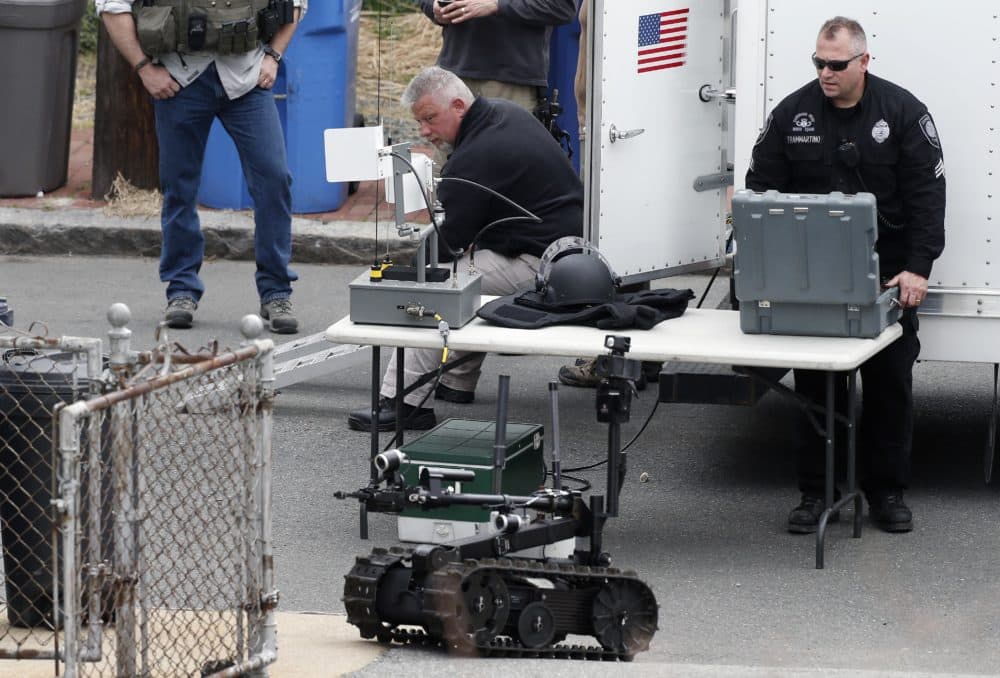Advertisement
Mass. State Police Tested Out Boston Dynamics’ Spot The Robot Dog. Civil Liberties Advocates Want To Know More
ResumeCops have long had dogs, and robots, to help them do their jobs. And now, they have a robot dog.
Massachusetts State Police is the first law enforcement agency in the country to use Boston Dynamics' dog-like robot, called Spot. While the use of robotic technology is not new for state police, the temporary acquisition of Spot — a customizable robot some have called “terrifying” — is raising questions from civil rights advocates about how much oversight there should be over police robotics programs.
The state’s bomb squad had Spot on loan from the Waltham-based Boston Dynamics for three months starting in August until November, according to records obtained by the American Civil Liberties Union of Massachusetts and reviewed by WBUR.
The documents do not reveal a lot of details on the robot dog’s exact use, but a state police spokesman said Spot, like the department’s other robots, was used as a “mobile remote observation device” to provide troopers with images of suspicious devices or potentially hazardous locations, like where an armed suspect might be hiding.
“Robot technology is a valuable tool for law enforcement because of its ability to provide situational awareness of potentially dangerous environments,” state police spokesman David Procopio wrote.
State police say Spot was used in two incidents, in addition to testing.
Boston Dynamics vice president for business development Michael Perry said the company wants Spot to have lots of different uses, in industries ranging from oil and gas companies, to construction, to entertainment. He envisions police sending Spot into areas that are too hazardous for a human — a chemical spill, or near a suspected bomb, or into a hostage situation.
“Right now, our primary interest is sending the robot into situations where you want to collect information in an environment where it's too dangerous to send a person, but not actually physically interacting with the space,” Perry said.
Spot is a “general purpose” robot, with an open API. That means customers — whether a police department or warehouse operator — can customize Spot with its own software. (State police say they didn't use this feature.) It has a 360-degree, low-light camera, and an arm.
For all of its potential, Boston Dynamics doesn’t want Spot weaponized. Perry said the lease agreements have a clause requiring the robot not be used in a way that would “physically harm or intimidate people.”
“Part of our early evaluation process with customers is making sure that we're on the same page for the usage of the robot,” he said. “So upfront, we're very clear with our customers that we don't want the robot being used in a way that can physically harm somebody.”
That’s one of the reasons why the company is opting for lease agreements, rather than a sale, Perry said. Boston Dynamics wants to be selective in which companies get access to Spot — and have the ability to take the equipment back if the lease is violated.
Worries About Weaponized Robots
Through Procopio, state police said the department never weaponized any of its robots, including Spot.
But while Spot and other tactical robots aren’t designed to kill, they still can. In 2016, Dallas Police sent a bomb disposal robot armed with explosives to kill a sniper who had shot at police officers and killed five. Experts said it was the first time a non-military robot had been used to intentionally kill a person.
That deadly potential, and lack of transparency about the state police’s overall robotics program, worries Kade Crockford, director of the technology for liberty program at the ACLU of Massachusetts. Crockford said they want to see a policy from state police about its use of robotics and a conversation about how and when robots should be used. State police didn’t say whether there’s a current policy about the use of robots, and the ACLU’s records request to the agency didn’t turn one up.
“We just really don't know enough about how the state police are using this,” Crockford said. “And the technology that can be used in concert with a robotic system like this is almost limitless in terms of what kinds of surveillance and potentially even weaponization operations may be allowed.”
“We just really don't know enough about how the state police are using this."
Kade Crockford
Beyond an agency policy, the ACLU is urging state and local lawmakers to enact laws or regulations at the state level to govern how increasingly advanced robots can be used. Nothing like that exists in Massachusetts now.
“We really need some law and some regulation to establish a floor of protection to ensure that these systems can't be misused or abused in the government's hands,” Crockford said. “And no, a terms of service agreement is just insufficient.”
Others, like Ryan Calo, a professor at the University of Washington School of Law who specializes in robotics and cyberlaw, agree that police agencies like state police need to put more thought into how robots are used and publicize that plan. They’re not equipment people are familiar with, like a car.
“There’s enough of a visceral reaction to the use of robotics that the smart thing to do is come up with a policy,” he said. “How is this going to be used? And compare the actual use to the stated policy. And they can weigh whether those uses are appropriate.”
Thor Eells, executive director of the National Tactical Officers Association and a former SWAT commander in Colorado, reiterated that, in most cases, robots are used in critical incidents — barricaded suspects, hostage situations or active assailants — not routine surveillance.
“Normally, when these types of tools are being deployed, it's pretty risky operation,” he said.
Eells said he recognizes the need for more information about how these robots are used and the concern about how they might infringe on people’s privacy or civil liberties. But he contended that police have to reach the same legal bar for, say, sending a robot into someone’s house. They would need a warrant.
“Normally, when these types of tools are being deployed, it's pretty risky operation.”
Thor Eells
“Those protections still exist,” he said. “They're not something that can be circumnavigated by the utilization of robotics. Law enforcement still has a responsibility to ensure that they're used legally as deemed so by the courts.”
Sometimes, though, technology used by police outpaces the law — like GPS tracking. In 2012, the Supreme Court ruled police couldn't place a GPS tracking device on a suspect's car without a warrant. The court ruled again for privacy in 2015, declaring that police must get a search warrant to access someone's cellphone location information.
Eells believes there’s a way to balance the community’s right to know about police tools used by law enforcement, and any necessary secrecy about specific tactics.
The Future Of Robotic Law Enforcement Is Already Here
Other than Spot, state police has a permanent fleet of robots. As of 2017, the bomb squad had 18 robotic platforms worth $1.8 million that are used on a weekly basis, according to police records. Most of those are tracked robots, not a legged robot like Spot.
But there’s something different about Spot. Calo, the professor, acknowledged there’s not a big operational difference between the robot dog and something like a more typically robot-looking PackBot. But, he said, Spot feels different. He pointed to a statement animal-rights group PETA put out, saying that it’s not cruel to kick Spot, because it’s not a real dog.

Robots in general fall in an area between machine and person, Calo said, even for robots like Spot, that are remote-controlled.
“There’s a social valiance of robots that affects our perceptions of them, and these are particularly evocative robots,” he said.
And there’s something about Spot that even excited state police troopers.
In one email in June, a lieutenant on the special tactical operations team wrote to a colleague, “Dude, it’s time,” with a link to a New York Post article headlined, “Boston Dynamics’ creepy dog-like robot is about to go on sale.”
In a different email in May, other troopers shared a YouTube video of Spot dancing to Bruno Mars and navigating a construction site.
A few months later, the troopers were behind the remote, using Spot in the field.
This program aired on November 25, 2019.
